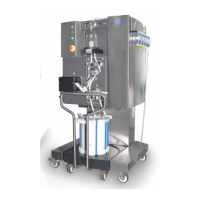
Do you have a question about the GE AKTA ready and is the answer not in the manual?
| Type | Chromatography System |
|---|---|
| Manufacturer | GE Healthcare |
| Flow Rate Range | 0.001 - 100 mL/min |
| pH Range | 2 - 12 |
| Power Requirements | 100-240 V AC, 50/60 Hz |
| Control Software | UNICORN |
| Applications | Protein purification, process development |
| Temperature Range | 4 to 40 °C |
| Sample Application | Manual injection |
Provides essential safety instructions and definitions of warnings, cautions, and notices for safe system operation.
Details manufacturing information and conformity with EU Directives for ÄKTA ready.
Lists generic and third-party documentation supplied with the ÄKTA ready system.
Covers general safety precautions, personal protection, and equipment handling during installation and operation.
Describes the system label, its location, and provides an example of its contents.
Provides information on emergency shutdowns and precautions during power failures.
Provides information on decontamination, product disposal, hazardous substances, and electrical components.
Explains the product pollution control information and the meaning of the Environment-friendly Use Period (EFUP) symbol.
Provides an overview of the intended use, material compliance, and key features of the ÄKTA ready system.
Illustrates the ÄKTA ready system with numbered parts and their functions, including the cabinet and column trolley.
Illustrates the liquid flow path through the ÄKTA ready system, indicating standard and optional components.
Explains the function and default positions of the 19 pinch valves used for flow control.
Introduces UNICORN software for ÄKTA ready control, its knowledge prerequisites, and system network configurations.
Details the system cabinet, column trolley, accessory kit contents, and associated products delivered with ÄKTA ready.
Specifies dimensions, weight, ambient environment, and precautions for installing the ÄKTA ready system.
Provides crate dimensions for ÄKTA ready and ÄKTA ready gradient, and instructions for moving the crate using lifting equipment.
Provides instructions for checking equipment for damage, safety precautions, and unpacking procedures.
Specifies required area, access for service, and instructions for locking the system wheels after positioning.
Details connector locations on the system cabinet and provides warnings for high voltage and power connection procedures.
Provides step-by-step instructions for starting UNICORN software and logging into the system.
Explains how to start the ÄKTA ready unit, including power-on procedures and indicator lamp status.
Details the three parts of ÄKTA ready flow kits: inlet manifold, pump tubing, and main part with sensors.
Explains the flow kit package contents and provides steps for unpacking the flow kit in a clean environment.
Introduces the step-by-step procedure for installing a flow kit onto the ÄKTA ready cabinet.
Describes the ÄKTA ready gradient pump, its components, and mounting location on the ÄKTA ready.
Details the two parts of the gradient flow section: pump tubing and jumper tubing, for connection to system and gradient pumps.
Explains pump calibration for capacity differences and the procedure for determining compensation factors.
Explains the purpose of the component test, testing sensors, flow meter, UV/conductivity, and pressure sensors.
Describes the structure and content of the flow kit installation and component test report, including header and sections.
Provides guidance on troubleshooting a failed component test by establishing the cause and using the installation wizard.
Recommends ReadyToProcess columns for ÄKTA ready and mentions other column types may require special precautions.
Introduces steps for installing a column, following the wizard and column-specific instructions.
Explains creating efficiency test methods and performing tests under stable conditions for installation report.
Explains column rinsing methods, procedures for removing storage solution, and selecting rinsing liquid.
Guides on adding new columns, like 'RTP columns on request', to the UNICORN column list for the installation wizard.
Introduces the Method Editor for building and editing methods using blocks and instructions.
Illustrates creating a method with blocks and instructions, focusing on basic chromatography method design.
Explains creating efficiency test methods and performing tests under stable conditions for installation report.
Covers precautions for hazardous substances, corrosive materials, and temperature limits before starting a run.
Guides on starting a run from UNICORN, checking inlets/outlets, and fine-tuning method variables.
Explains how to view chromatograms in the UNICORN Evaluation module and customize panel layouts.
Provides instructions for disposing of flow kit and column, including washing, draining, and remounting protective caps.
Emphasizes regular maintenance for safe operation, focusing on cleaning and pH electrode calibration.
Outlines preventive maintenance performed annually by qualified personnel, and user-checkable tasks like air filter and sensors.
Lists user-replaceable parts like pressure cell holder kits, air filter nuts, and wheels, and refers to ordering information.
Provides instructions for system storage, including removing flow kits, cleaning the cabinet, and switching off power.
Covers troubleshooting for computer issues like no system found or communication failure, and power/compressed air failures.
Provides general specifications for ÄKTA ready and ÄKTA ready gradient, including dimensions, weight, and voltage.
Lists materials used in ÄKTA ready components that come into contact with process liquids.
Discusses chemical compatibility for wetted parts and lists allowed chemicals and their concentrations for ÄKTA ready.
Provides ordering information for ÄKTA ready flow kits, gradient flow sections, accessories, and spare parts.
Introduces PID control principles for feedback control and its application in the ÄKTA ready system.
Presents a checklist for performed tasks, including unpacking and installation of the system unit.
Provides a form for confirming the equipment is cleaned and the area is safe for on-site service engineers.
Directs users to system documentation for spare parts, accessories, method optimization, and contact information.